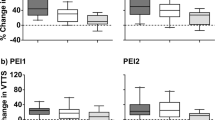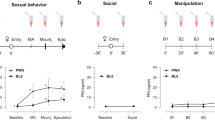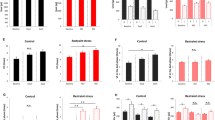Abstract
By observation of Sprague–Dawley male rats with different ejaculatory behaviors, we have identified distinct behavioral characteristics in rapid ejaculator rats. To validate these differential behaviors, we conducted multifaceted behavioral experiments on rapid ejaculator rats and normal rats. Through mating experiments, 42 male rats were categorized into 5 rapid ejaculator rats, 29 normal ejaculator rats, and 8 sluggish ejaculator rats according to their ejaculation frequency. We selected 5 rats exhibiting rapid ejaculation and 5 rats with normal ejaculation for participation in the Morris water maze, open-field test, and balance beam experiments. The open-field tests revealed that rapid ejaculator rats spent shorter time in the center region (1.23 ± 1.21 vs. 6.56 ± 2.40 s, P = 0.0041), less entered the center region (0.80 ± 0.75 vs. 3.40 ± 1.50, time, P = 0.0145), traveled shorter distances (17,003.77 ± 3339.42 vs. 25,037.90 ± 5499.94 mm, P = 0.0371), and had a lower average speed compared with normal rats (66.09 ± 62.36 vs. 195.56 ± 83.41 mm/s, P = 0.0377). However, no significant differences were observed in the Morris water maze and balance beam experiments (0.25 ± 0.05 vs. 0.26 ± 0.07, P = 0.7506;16.40 ± 3.77 vs. 16.25 ± 2.05, P = 0.9515). These behavioral results indicated that the rapid ejaculator rats were more prone to anxiety. To further substantiate this claim, we examined Brain-derived neurotrophic factor expression levels in the hippocampus of rat brains using immunohistochemistry and western blotting. The results demonstrate lower Brain-derived neurotrophic factor expression in the hippocampus of rapid ejaculator rats compared with that in normal rats (P = 0.0093). Thus, our experiments indicate that rapid ejaculator rats exhibit a higher propensity for anxiety, potentially linked to their abnormal neurophysiologic state. It is concluded that rapid ejaculator rats may be more susceptible to anxiety on a pathophysiological basis.
This is a preview of subscription content, access via your institution
Access options
Subscribe to this journal
Receive 8 print issues and online access
$259.00 per year
only $32.38 per issue
Buy this article
- Purchase on Springer Link
- Instant access to full article PDF
Prices may be subject to local taxes which are calculated during checkout


Similar content being viewed by others
Data availability
All data generated or analyzed during this study can be obtained by contacting me via email (13913957628@163.com).
References
Moreira ED Jr, Brock G, Glasser DB, Nicolosi A, Laumann EO, Paik A, et al. Help-seeking behaviour for sexual problems: the global study of sexual attitudes and behaviors. Int J Clin Pract. 2005;59:6–16.
Serefoglu EC, McMahon CG, Waldinger MD, Althof SE, Shindel A, Adaikan G, et al. An evidence-based unified definition of lifelong and acquired premature ejaculation: report of the second International Society for Sexual Medicine Ad Hoc Committee for the Definition of Premature Ejaculation. Sex Med. 2014;2:41–59.
Alwaal A, Breyer BN, Lue TF. Normal male sexual function: emphasis on orgasm and ejaculation. Fertil Steril. 2015;104:1051–60.
Rowland DL, Crawford SB. Idiosyncratic heart rate response in men during sexual arousal. J Sex Med. 2011;8:1383–9.
Zorba OU, Cicek Y, Uzun H, Çetinkaya M, Önem K, Rifaioğlu MM. Autonomic nervous system dysfunction in lifelong premature ejaculation: analysis of heart rate variability. Urology. 2012;80:1283–6.
Guinjoan SM, Bonanni Rey RA, Cardinali DP. Correlation between skin potential response and psychopathology in patients with affective disorders. Neuropsychobiology. 1995;31:24–3.
Owens A, Low D, Iodice V, Mathias C, Critchley H. Emotion and the autonomic nervous system-a two-way street: insights from affective, autonomic and dissociative disorders. In: Reference module in neuroscience and biobehavioral psychology. Elsevier: Amsterdam; 2017. p. 1–15.
Pattij T, de Jong TR, Uitterdijk A, Waldinger MD, Veening JG, Cools AR, et al. Individual differences in male rat ejaculatory behaviour: searching for models to study ejaculation disorders. Eur J Neurosci. 2005;22:724–34.
Morris RGM. Spatial localization does not require the presence of local cues. Learn Motiv. 1981;12:239–60.
Hall C. Emotional behavior in the rat. I. Defecation and urination as measures of individual differences in emotionality. J Comp Psychol. 1934;18:385–403.
Bartikofsky D, Hertz MJ, Bauer DS, Altschuler R, King WM, Stewart CE. Balance beam crossing times are slower after noise exposure in rats. Front Integr Neurosci. 2023;17:1196477.
Waldinger MD. The neurobiological approach to premature ejaculation. J Urol. 2002;168:2359–67.
Guo L, Liu Y, Wang X, Yuan M, Yu Y, Zhang X, et al. Significance of penile hypersensitivity in premature ejaculation. Sci Rep. 2017;7:10441.
Chen X, Wang FX, Hu C, Yang NQ, Dai JC. Penile sensory thresholds in subtypes of premature ejaculation: implications of comorbid erectile dysfunction. Asian J Androl. 2018;20:330–5.
Huang Y, Zhang X, Gao J, Tang D, Gao P, Peng D, et al. Association of STin2 VNTR polymorphism of serotonin transporter gene with lifelong premature ejaculation: a case-control study in Han Chinese subjects. Med Sci Monitor. 2016;22:3588–94.
Shamloul R, el-Nashaar A. Chronic prostatitis in premature ejaculation: a cohort study in 153 men. J Sex Med. 2006;3:150–4.
Zhang Y, Li X, Zhou K, Zhou M, Xia K, Xu Y, et al. Influence of experimental autoimmune prostatitis on sexual function and the anti-inflammatory efficacy of celecoxib in a rat model. Front Immunol. 2020;11:574212.
Cinar O, Durmus N, Aslan G, Demir O, Evcim AS, Gidener S, et al. Effects of the dopamine D3 receptor agonist 7-hydroxy-2-(di-N-propylamino) tetralin in hyperthyroidism-induced premature ejaculation rat model. Andrologia. 2018. https://doi.org/10.1111/and.12956.
Xia JD, Chen J, Yang BB, Sun HJ, Zhu GQ, Dai YT, et al. Differences in sympathetic nervous system activity and NMDA receptor levels within the hypothalamic paraventricular nucleus in rats with differential ejaculatory behavior. Asian J Androl. 2018;20:355–9.
Zhang QJ, Yang BB, Yang J, Wang YM, Dai YT, Song NH, et al. Inhibitory role of gamma-aminobutyric receptors in paraventricular nucleus on ejaculatory responses in rats. J Sex Med. 2020;17:614–22.
Yang B, Hong Z, Luse DC, Han Y, Sun G, Feng Y, et al. The diagnostic role of neurophysiological tests for premature ejaculation: a prospective multicenter study. J Urol. 2022;207:172–82.
Voltas N, Hernández-Martínez C, Arija V, Canals J. The natural course of anxiety symptoms in early adolescence: factors related to persistence. Anxiety Stress Coping. 2017;30:671–86.
Ghandour RM, Sherman LJ, Vladutiu CJ, Ali MM, Lynch SE, Bitsko RH, et al. Prevalence and treatment of depression, anxiety, and conduct problems in US children. J Pediatr. 2019 Mar;206:256–.e3.
Katzman MA, Bleau P, Blier P, Chokka P, Kjernisted K, Van Ameringen M, et al. Canadian clinical practice guidelines for the management of anxiety, posttraumatic stress and obsessive-compulsive disorders. BMC Psychiatry. 2014;14:S1.
Althof SE, McMahon CG, Waldinger MD, Serefoglu EC, Shindel AW, Adaikan PG, et al. An update of the International Society of Sexual Medicine’s Guidelines for the diagnosis and treatment of premature ejaculation (PE). Sex Med. 2014;2:60–90.
Blier P. Neurobiology of depression and mechanism of action of depression treatments. J Clin Psychiatry. 2016;77:e319.
Xia JD, Zhou LH, Han YF, Chen Y, Wang R, Dai YT. A reassessment of penile sensory pathways and effects of prilocaine-lidocaine cream in primary premature ejaculation. Int J Impot Res. 2014;26:186–90.
Xia JD, Han YF, Zhou LH, Xu ZP, Chen Y, Dai YT. Sympathetic skin response in patients with primary premature ejaculation. Int J Impot Res. 2014;26:31–34.
Xia J, Chen T, Chen J, Han Y, Xu Z, Zhou L, et al. The sympathetic skin response located in the penis as a predictor of the response to sertraline treatment in patients with primary premature ejaculation. J Sex Med. 2014;11:2801–8.
Yang Y, Lu Y, Song Y, Chen H, Liu X. Correlations and stratification analysis between premature ejaculation and psychological disorders. Andrologia. 2019;51:e13315.
Lu B, Nagappan G, Guan X, Nathan PJ, Wren P. BDNF-based synaptic repair as a disease-modifying strategy for neurodegenerative diseases. Nat Rev Neurosci. 2013;14:401–16.
Yin JB, Wu HH, Dong YL, Zhang T, Wang J, Zhang Y, et al. Neurochemical properties of BDNF-containing neurons projecting to rostral ventromedial medulla in the ventrolateral periaqueductal gray. Front Neural Circuits. 2014;8:137.
Hempstead BL. Brain-derived neurotrophic factor: three ligands, many actions. Trans Am Clin Climatol Assoc. 2015;126:9–19.
Deltheil T, Guiard BP, Cerdan J, David DJ, Tanaka KF, Repérant C, et al. Behavioral and serotonergic consequences of decreasing or increasing hippocampus brain-derived neurotrophic factor protein levels in mice. Neuropharmacology. 2008;55:1006–14.
Qiao H, An SC, Xu C, Ma XM. Role of proBDNF and BDNF in dendritic spine plasticity and depressive-like behaviors induced by an animal model of depression. Brain Res. 2017;1663:29–37.
Ieraci A, Mallei A, Popoli M. Social isolation stress induces anxious-depressive-like behavior and alterations of neuroplasticity-related genes in adult male mice. Neural Plast. 2016;2016:6212983.
Casagrande BP, Ribeiro AM, Pisani LP, Estadella D. Hippocampal BDNF mediated anxiety-like behaviours induced by obesogenic diet withdrawal. Behav Brain Res. 2023;436:114077.
Zhang JC, Yao W, Hashimoto K. Brain-derived neurotrophic factor (BDNF)-TrkB signaling in inflammation-related depression and potential therapeutic targets. Curr Neuropharmacol. 2016;14:721–31.
Huang Y, Peng D, Geng H, Dai Y, Jiang H, Zhang X. Expression of brain-derived neurotrophic factor in rapid ejaculator rats: a further study. Andrologia. 2021;53:e14134.
Atik YT, Gokce A, Halis F, Cimen HI. Can low serum brain-derived neurotrophic factor levels be associated with lifelong premature ejaculation?; A pilot study. Andrologia. 2020;52:e13746.
Acknowledgements
Thanks to Dr. Yerong Jiang for her guidance on this paper.
Author information
Authors and Affiliations
Contributions
Chunlu Xu drafted the manuscript. Tao Song carried out the Immunohistochemistry and Western Blot and performed the statistical analysis. Ning Wu carried out the Copulation test and participated in the revision work. Yutian Dai conceived of the study, and participated in its design and coordination and helped to draft the manuscript. All authors read and approved the final manuscript.
Corresponding authors
Ethics declarations
Competing interests
The authors declare no competing interests.
Additional information
Publisher’s note Springer Nature remains neutral with regard to jurisdictional claims in published maps and institutional affiliations.
Rights and permissions
Springer Nature or its licensor (e.g. a society or other partner) holds exclusive rights to this article under a publishing agreement with the author(s) or other rightsholder(s); author self-archiving of the accepted manuscript version of this article is solely governed by the terms of such publishing agreement and applicable law.
About this article
Cite this article
Xu, C., Wu, N., Song, T. et al. Rapid ejaculator rats are more susceptible to anxiety compared with normal ejaculator rats. Int J Impot Res (2024). https://doi.org/10.1038/s41443-024-00888-5
Received:
Revised:
Accepted:
Published:
DOI: https://doi.org/10.1038/s41443-024-00888-5



